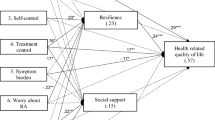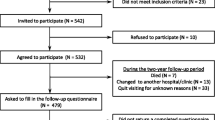Abstract
Individual differences in adjustment during a disease’s course determine psychological response and outcome. This study aimed to investigate prospectively whether coping with health stressors and self-sacrificing defense style could predict psychological adjustment and health-related quality of life (HRQoL) in patients with rheumatoid arthritis (RA). Seventy-four consecutive RA patients attending a rheumatology clinic were assessed for psychological distress (SCL-90-R), sense of coherence (SOC scale), self-sacrificing defense style (Defense Style Questionnaire-88), disease activity (DAS-28), pain, disability (Health Assessment Questionnaire) and HRQoL (World Health Organization Quality of Life Instrument, Short Form) at baseline and 5 years later. Multiple regression and moderator analyses were carried out. The results showed that disease activity (p < .001), pain (p = .005), psychological distress (p = .031), social relations HRQoL (p = .042) and environment HRQoL (p = .020) significantly improved over time. SOC was found an independent predictor of improvement in psychological distress (p = .003), overall general health (p = .002) and social relations HRQoL (p = .004); self-sacrificing independently predicted environment HRQoL (p = .042). The self-sacrificing defense style moderated the relationships between improvement in pain and improvement in overall general health (p = .024) and between improvement in pain and improvement in social relations HRQoL (p = .006). These findings indicate that, in RA, SOC predicts improvement in psychological distress and HRQoL over time, while a self-sacrificing defense style moderates the relationship of pain with HRQoL in the long term. These variables may partly explain inter-individual differences in adaptation to RA. Therefore, the design of psychotherapeutic trials targeting the patients’ defensive profiles and coping with health stressors capacities is an important research perspective.


Similar content being viewed by others
References
Boonen A, Severens JL (2011) The burden of illness of rheumatoid arthritis. Clin Rheumatol 30(Suppl. 1):S3–S8
Dickens C, McGowan L, Clark-Carter D, Creed F (2002) Depression in rheumatoid arthritis: a systematic review of the literature with meta-analysis. Psychosom Med 64:52–60
Katon W, Ciechanowski P (2002) Impact of major depression on chronic medical illness. J Psychosom Res 53:859–863
Uhlig T, Smedstad LM, Vaglum P, Moum T, Gerard N, Kvien TK (2000) The course of rheumatoid arthritis and predictors of psychological, physical and radiographic outcomes after 5 years of follow-up. Rheumatology 39:732–741
Evers AW, Kraaimaat FW, Geenen R, Jacobs JW, Bijlsma JW (2002) Long term predictors of anxiety and depressed mood in early rheumatoid arthritis: a 3 and 5 year follow up. J Rheumatol 29:2327–2336
Norton S, Sacker A, Young A, Done J (2011) Distinct psychological distress trajectories in rheumatoid arthritis: findings from an inception cohort. J Psychosom Res 71:290–295
Nicassio PM (2011) Heterogeneity in the response to rheumatoid arthritis (RA): the challenge of accounting for individual variability in the face of chronic disease. J Psychosom Res 71:288–289
Yelin EH, Katz PP (2002) Focusing interventions for disability among patients with rheumatoid arthritis. Arthritis Rheum 47:231–233
Antonovsky A (1987) Unraveling the mystery of health. How people manage stress and stay well. Jossey-Bass, San Francisco
Suominen S, Helenius H, Blomberg H, Uutela A, Koskenvuo M (2001) Sense of coherence as predictor of subjective state of health: results of 4 years of follow-up of adults. J Psychosom Res 50:77–86
Eriksson M, Lindström B (2007) Antonovsky’s sense of coherence scale and its relation with quality of life: a systematic review. J Epidemiol Community Health 61:938–944
American Psychiatric Association (2004) Diagnostic and statistical manual of mental disorders, 4th edn. American Psychiatric Press, Washington, DC
Malone JC, Cohen S, Liu SR, Vaillant GE, Waldinger RJ (2013) Adaptive midlife defense mechanisms and late-life health. Pers Individ Differ 55:85–89
Calati R, Oasi O, De Ronchi D, Serretti A (2010) The use of the defence style questionnaire in major depressive and panic disorders: a comprehensive meta-analysis. Psychol Psychother 83:1–13
Beresford TP, Alfers J, Mangum L, Clapp L, Martin B (2006) Cancer survival probability as a function of ego defense (adaptive) mechanisms versus depressive symptoms. Psychosomatics 47:247–253
Bond M (1992) An empirical study of defense styles: the defense style questionnaire. In: Vaillant GE (ed) Ego mechanisms of defense: a guide for clinicians and researchers. American Psychiatric p, Washington, DC, p 137
Horowitz LM, Alden LE, Wiggins JS, Pincus AL (2000) The inventory of interpersonal problems (IIP). Psychological Corporation, San Antonio
Repetti RL, Taylor SE, Seeman TE (2002) Risky families: family social environments and the mental and physical health of offspring. Psychol Bull 128:230–266
Büchi S, Sensky T, Allard S et al (1998) Sense of coherence–a protective factor for depression in rheumatoid arthritis. J Rheumatol 25:869–875
Callahan LF, Pincus T (1995) The sense of coherence scale in patients with rheumatoid arthritis. Arthritis Care Res 8:28–35
Hyphantis TN, Tsifetaki N, Siafaka V et al (2007) The impact of psychological functioning upon systemic sclerosis patients’ quality of life. Semin Arthritis Rheum 37:81–92
Bai M, Tomenson B, Creed F et al (2009) The role of psychological distress and personality variables in the disablement process in rheumatoid arthritis. Scand J Rheumatol 38:419–430
Arnett FC, Edworthy SM, Bloch DA et al (1988) The American Rheumatism Association 1987 revised criteria for the classification of rheumatoid arthritis. Arthritis Rheum 31:315–324
Prevoo ML, van’t Hof MA, Kuper HH, van Leeuwen MA, van de Putte LB, van Riel PL (1995) Modified disease activity scores that include twenty-eight-joint counts: development and validation in a prospective longitudinal study of patients with rheumatoid arthritis. Arthritis Rheum 38:44–48
Chatzitheodorou D, Kabitsis C, Papadopoulos NG, Galanopoulou V (2008) Assessing disability in patients with rheumatic diseases: translation, reliability and validity testing of a Greek version of the Stanford Health Assessment Questionnaire (HAQ). Rheumatol Int 28:1091–1097
Donias S, Karastergiou A, Manos N (1991) Standardization of the symptom checklist-90-R rating scale in a Greek population. Psychiatrike 2:42–48
Ginieri-Coccossis M, Triantafillou E, Tomaras V, Soldatos C, Mavreas V, Christodoulou G (2012) Psychometric properties of WHOQOL-BREF in clinical and health Greek populations: incorporating new culture-relevant items. Psychiatrike 23:130–142
Karalis I, Langius A, Tsirogianni M, Faresjo T, Nettelbladt P, Lionis C (2004) The translation-validation of the sense of coherence scale into Greek and its use in primary health care. Arch Hell Med 21:195–203
Hyphantis T (2010) The Greek version of the Defense Style Questionnaire: psychometric properties in three different samples. Compr Psychiatry 51:618–629
Kraemer HC, Frank E, Kupfer DJ (2006) Moderators of treatment outcomes: clinical, research, and policy importance. JAMA 296:1286–1289
Miles J, Shevlin M (2003) Applying regression and correlation. Sage, London, pp 126–132
Little RJ, Rubin DB (1987) Statistical analysis with missing data. Wiley, New York
Welsing PM, van Gestel AM, Swinkels HL, Kiemeney LA, van Riel PL (2009) The relationship between disease activity, joint destruction, and functional capacity over the course of rheumatoid arthritis. Arthritis Rheum 44:2009–2017
Escalante A, del Rincón I (1999) How much disability in rheumatoid arthritis is explained by rheumatoid arthritis? Arthritis Rheum 42:1712–1721
Kanecki K, Tyszko P, Wisłowska M, Łyczkowska-Piotrowska J (2013) Preliminary report on a study of health-related quality of life in patients with rheumatoid arthritis. Rheumatol Int 33:429–434
Thyberg I, Skogh T, Hass UA, Gerdle B (2005) Recent-onset rheumatoid arthritis: a 1-year observational study of correlations between health-related quality of life and clinical/laboratory data. J Rehabil Med 37:159–165
Strating MM, Van Schuur WH, Suurmeijer TP (2007) Predictors of functional disability in rheumatoid arthritis: results from a 13-year prospective study. Disabil Rehabil 29:805–815
Schnyder U, Büchi S, Sensky T, Klaghofer R (2000) Antonovsky’s sense of coherence: trait or state? Psychother Psychosom 69:296–302
Alivia M, Guadagni P, Roberti di Sarsina P (2011) Towards salutogenesis in the development of personalised and preventive healthcare. EPMA J 2:381–384
Bäärnhielm S (2004) Restructuring illness meaning through the clinical encounter: a process of disruption and coherence. Cult Med Psychiatry 28:41–65
Sandell R, Blomberg J, Lazar A, Carlsson J, Broberg, J, Schubert J (2000) Varieties of long-term outcome among patients in psychoanalysis and long-term psychotherapy: a review of findings in the Stockholm Outcome of Psychoanalysis and Psychotherapy Project (STOPP). Int J Psychoanal 81(Pt 5):921–42
Graziano F, Calandri E, Borghi M, Bonino S (2014) The effects of a group-based cognitive behavioral therapy on people with multiple sclerosis: a randomized controlled trial. Clin Rehabil 28:264–274
Lane JD, McCaskill CC, Williams PG, Parekh PI, Feinglos MN, Surwit RS (2000) Personality correlates of glycemic control in type 2 diabetes. Diabetes Care 23:1321–1325
Hyphantis T, Kaltsouda A, Triantafillidis J et al (2005) Personality correlates of adherence to type 2 diabetes regimens. Int J Psychiatry Med 35:103–107
Lackner JM, Gurtman MB (2005) Patterns of interpersonal problems in irritable bowel syndrome patients: a circumplex analysis. J Psychosom Res 58:523–532
Bond M (2004) Empirical studies of defense style: relationships with psychopathology and change. Harv Rev Psychiatry 12:263–278
Bond M, Perry JC (2004) Long-term changes in defense styles with psychodynamic psychotherapy for depressive, anxiety, and personality disorders. Am J Psychiatry 161:1665–1671
Perry JC, Bond M (2012) Change in defense mechanisms during long-term dynamic psychotherapy and five-year outcome. Am J Psychiatry 169:916–925
Faul F, Erdfelder E, Lang A-G, Buchner A (2007) G*Power 3: a flexible statistical power analysis program for the social, behavioral, and biomedical sciences. Behav Res Methods 39:175–191
Faul F, Erdfelder E, Buchner A, Lang A-G (2009) Statistical power analyses using G*Power 3.1: tests for correlation and regression analyses. Behav Res Methods 41:1149–1160
Conflict of interest
None.
Author information
Authors and Affiliations
Corresponding author
Rights and permissions
About this article
Cite this article
Goulia, P., Voulgari, P.V., Tsifetaki, N. et al. Sense of coherence and self-sacrificing defense style as predictors of psychological distress and quality of life in rheumatoid arthritis: a 5-year prospective study. Rheumatol Int 35, 691–700 (2015). https://doi.org/10.1007/s00296-014-3134-8
Received:
Accepted:
Published:
Issue Date:
DOI: https://doi.org/10.1007/s00296-014-3134-8




